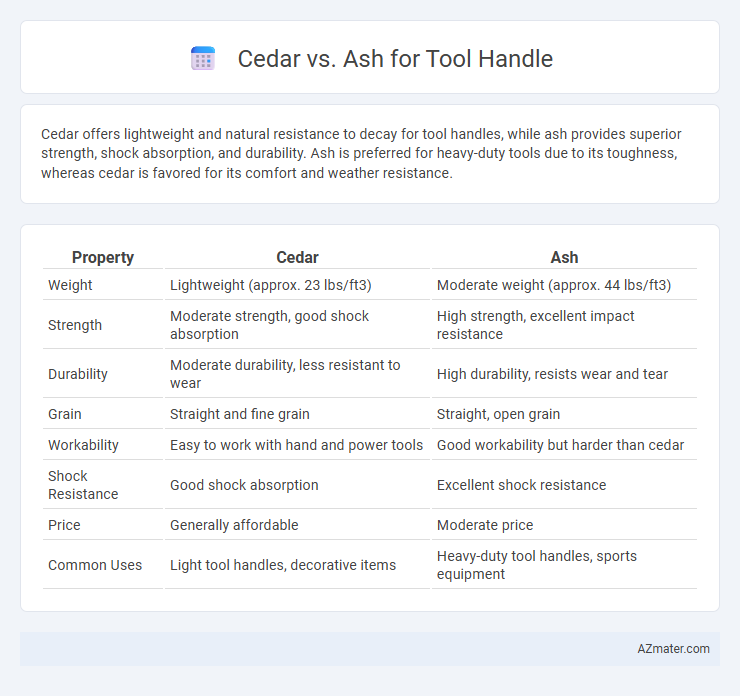Cedar offers lightweight and natural resistance to decay for tool handles, while ash provides superior strength, shock absorption, and durability. Ash is preferred for heavy-duty tools due to its toughness, whereas cedar is favored for its comfort and weather resistance.
Table of Comparison
| Property | Cedar | Ash |
|---|---|---|
| Weight | Lightweight (approx. 23 lbs/ft3) | Moderate weight (approx. 44 lbs/ft3) |
| Strength | Moderate strength, good shock absorption | High strength, excellent impact resistance |
| Durability | Moderate durability, less resistant to wear | High durability, resists wear and tear |
| Grain | Straight and fine grain | Straight, open grain |
| Workability | Easy to work with hand and power tools | Good workability but harder than cedar |
| Shock Resistance | Good shock absorption | Excellent shock resistance |
| Price | Generally affordable | Moderate price |
| Common Uses | Light tool handles, decorative items | Heavy-duty tool handles, sports equipment |
Introduction to Cedar and Ash Wood
Cedar wood is lightweight, naturally resistant to decay and insects, making it a durable choice for tool handles that require longevity and ease of use. Ash wood is known for its exceptional strength, shock resistance, and flexibility, providing tool handles with superior impact absorption and durability under heavy use. Both cedar and ash offer distinct advantages, with cedar excelling in weather resistance and ash favored for its toughness and ergonomic comfort.
Key Properties of Cedar for Tool Handles
Cedar offers excellent durability and natural resistance to moisture and decay, making it ideal for tool handles exposed to varying weather conditions. Its lightweight yet sturdy composition provides superior shock absorption and reduces user fatigue during prolonged use. Additionally, cedar's smooth texture and fine grain facilitate comfortable gripping and precision handling for diverse tool applications.
Key Properties of Ash for Tool Handles
Ash is favored for tool handles due to its exceptional strength-to-weight ratio, providing durability without excessive weight. Its straight grain and excellent shock resistance reduce vibration impacts, enhancing user comfort and control. The wood's high flexibility and ability to withstand repeated stress make it ideal for tools requiring resilience and long-lasting performance.
Strength and Durability Comparison
Ash wood offers superior strength and durability compared to cedar, making it ideal for tool handles that require resistance to impact and wear. Ash's dense grain structure provides excellent shock absorption and flexibility, reducing the chance of handle breakage during heavy use. Cedar, while lightweight and resistant to rot, lacks the hardness and toughness necessary for long-lasting tool handles subjected to rigorous tasks.
Weight and Balance Considerations
Ash is commonly chosen for tool handles due to its excellent strength-to-weight ratio, providing a lightweight yet durable option that supports effective balance. Cedar, while lighter than ash, lacks the same density and strength, which can affect tool stability and overall control during use. When selecting a tool handle, prioritizing ash often results in better weight distribution and balance, essential for prolonged, precise work.
Resistance to Moisture and Decay
Ash wood exhibits superior resistance to moisture and decay compared to cedar, making it a more durable choice for tool handles exposed to damp environments. Cedar contains natural oils that provide moderate resistance to rot, but it is generally softer and more prone to wear under heavy use. For long-lasting tool handles, ash's dense grain structure offers enhanced strength and better performance in humid or wet conditions.
Grip Comfort and Ergonomics
Ash wood offers superior grip comfort and ergonomics for tool handles due to its straight grain and shock-absorbing properties, reducing hand fatigue during extended use. Cedar, while lightweight and soft, tends to be less durable and may compress under pressure, compromising grip stability and ergonomic effectiveness. Tool handles crafted from ash provide a balanced combination of strength, tactile comfort, and ergonomic design essential for precision and control.
Workability and Finishing Qualities
Ash offers superior workability for tool handles due to its straight grain and excellent shock resistance, making it easy to shape and durable under heavy use. Cedar, while softer and lighter, provides a smooth finishing quality with a natural resistance to moisture and decay, resulting in a comfortable grip and long-lasting appearance. Ash handles typically require more effort to finish but yield a robust, resilient tool, whereas cedar handles excel in ergonomic comfort and aesthetic appeal.
Cost and Availability Factors
Ash is generally more affordable and widely available compared to cedar, which can be pricier due to its limited supply and demand for specialty woodworking. The abundant growth of ash trees in North America ensures a steady supply, making it a cost-effective choice for tool handles. Cedar, while valued for its lightweight and resistance to moisture, often commands higher prices and may be harder to source in large quantities.
Which Wood is Best for Your Tool Handle?
Ash wood offers superior strength and shock resistance, making it an excellent choice for durable tool handles that withstand heavy use. Cedar is lighter and naturally resistant to rot and insects, ideal for tools exposed to outdoor or humid conditions. Choosing between ash and cedar depends on whether you prioritize toughness and impact absorption or lightweight durability and environmental resistance for your tool handle.

Infographic: Cedar vs Ash for Tool Handle
 azmater.com
azmater.com